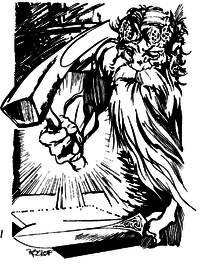In the fantasy role-playing game Dungeons & Dragons, an Outer Plane is one of a number of general types of planes of existence. They can also be referred to as godly planes, spiritual planes or divine planes. The Outer Planes are home to beings such as deities and otherworldly creatures such as demons, celestials and devils. Each Outer Plane is usually the physical manifestation of a particular moral and ethical alignment and the entities that dwell there often embody the traits related to that alignment.

Lolth is a fictional goddess in the Dungeons & Dragons fantasy role-playing game. Lolth, the Demon Queen of Spiders, is the chief goddess of drow elves. She is also known as the Spider Queen and the Queen of the Demonweb Pits.
The half-orc is a fictional creature born to mixed orc and human parentage in the Dungeons & Dragons role-playing game. The half-orc is a playable race for D&D player characters. Half-orcs are typically born in wild frontiers where human and orc tribes come into contact. Half-orcs are between six and seven feet tall (180–210 cm) and usually weigh between 180 and 250 pounds (80–110 kg). This makes them less bulky and more agile than pure-bred orcs, but still taller and stronger than most humans. Half-orcs have pale green skin, jutting jaws, prominent teeth and coarse body-hair.

Moradin is the chief deity in the dwarven pantheon in the Dungeons & Dragons game and is a member of the default D&D pantheon. In 3rd edition, Moradin's domains are Creation, Earth, Good, Law, and Protection. The 5th Edition Players Handbook include Knowledge as a suggested domain. His titles include Soul Forger, Dwarffather, the All-Father, and the Creator. He created the first dwarves out of earthen materials and tutored them in dwarven ways.
In some versions of the Dungeons and Dragons roleplaying game, Saint Cuthbert of the Cudgel is the combative deity of Wisdom, Dedication, and Zeal. Originally created for the World of Greyhawk campaign setting, he was later made part of the generic "core pantheon" for the game's third edition.
In the Dungeons & Dragons fantasy role-playing game, Acheron, also known as The Infernal Battlefield of Acheron, is a lawful neutral/lawful evil-aligned plane of existence. It is one of a number of alignment-based Outer Planes that form part of the standard Dungeons & Dragons(D&D) cosmology, used in the Planescape, Greyhawk and some editions of the Forgotten Realms campaign settings.
In the World of Greyhawk campaign setting for the Dungeons & Dragons fantasy roleplaying game, Tharizdun is the god of Eternal Darkness, Decay, Entropy, Malign Knowledge, Insanity, and Cold.
In the Dungeons and Dragons fantasy role-playing game, Gehenna is a plane of existence of neutral evil/lawful evil alignment. It is one of a number of alignment-based Outer Planes that form part of the standard Dungeons & Dragons(D&D) cosmology, used in the Planescape, Greyhawk and some editions of the Forgotten Realms campaign settings. It borders the Gray Waste of Hades and the Nine Hells of Baator.
In the World of Greyhawk campaign setting and in the default pantheon of deities for the third edition of the Dungeons & Dragons role-playing game, Ehlonna is the goddess of Forests, Woodlands, Flora, Fauna, and Fertility. Ehlonna is known to the elves as "Ehlenestra." Her holy symbol is a rampant unicorn or a unicorn's horn.

In the Dungeons & Dragons roleplaying game, orcs are a primitive race of savage, bestial, barbaric humanoid.
In the World of Greyhawk campaign setting for the Dungeons & Dragons role-playing game, Istus is the goddess of Fate, Destiny, Divination, the Future, and Honesty. She is known as the Lady of Our Fate and the Colorless and All-Colored. Her symbol is a golden spindle with three strands.
Procan is a fictional deity in the World of Greyhawk campaign setting for the Dungeons & Dragons role-playing game. Procan is the Oeridian god of seas, sea life, salt, sea weather, and navigation. His holy symbol is a gold and coral trident above or piercing a cresting wave.
In the World of Greyhawk campaign setting for the Dungeons & Dragons role-playing game, Trithereon is the god of Individuality, Liberty, Retribution, and Self-Defense. His holy symbol is the Rune of Pursuit, which resembles the triskelion.

In the Dungeons & Dragons fantasy roleplaying game, hobgoblins are a larger, stronger, smarter and more menacing form of goblins. They are smaller and weaker than bugbears, but better organized. Hobgoblins are humanoids that stand nearly 6'6" tall on average, a little taller than orcs. Smarter than other goblinoid races, they are renowned for their brutality and military skill.

The halfling is a fictional race found in the Dungeons & Dragons fantasy role-playing game. Halflings are similar to humans, but about half their size. The original Dungeons & Dragons included hobbits, but later the game began using the name "halfling" as an alternative to "hobbit" for legal reasons.

